
Explicación de procesos
Creating an Out of Range Alarm
You create an out of range alarm to trigger an alarm when a variable, such as a temperature, is not within its specified range.
In WorkStation, in the System Tree pane, select the folder or SmartStruxure server where you want to create the alarm.
On the File menu, point to New and then click Alarm .
In the object type list, select Out of Range Alarm .
action_zoom_plus_stroke 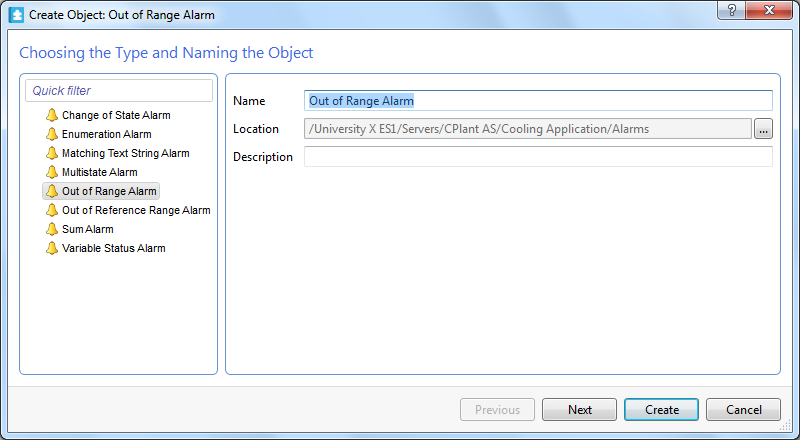
In the Name box, type a name for the alarm.
In the Description box, type a description for the alarm.
Click Next .
In the Upper limit box, enter an upper limit for the alarm.
action_zoom_plus_stroke 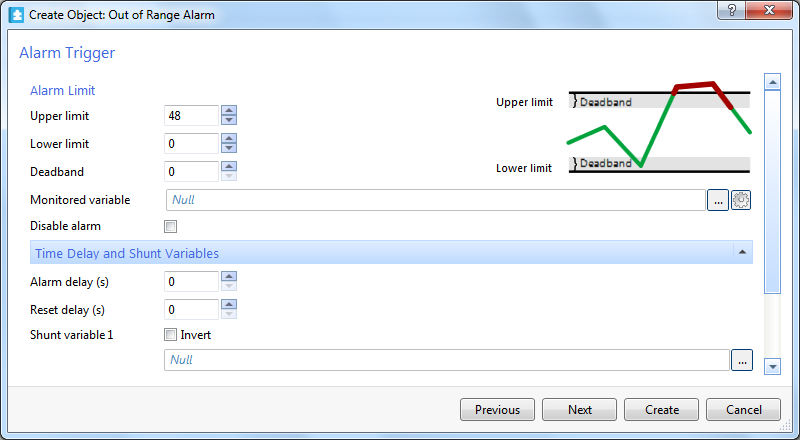
In the Lower limit box, enter a lower limit for the alarm.
In the Deadband box, enter a deadband for the alarm.
In the Monitored variable box, enter the variable that the alarm monitors.
Click the Set unit button
to enter or change the unit of measure for the alarm limits and deadband.action_zoom_plus_stroke  Aviso
AvisoIf the monitored value has a unit of measurement defined, the alarm limits and deadband are assigned that unit by default.
Select the unit of measure.
action_zoom_plus_stroke 
In the Prefix box, select a prefix for the unit.
Click Select .
In the Disable alarm box, select to create the alarm in disabled mode.
Under Time Delay and Shunt Variables , in the Alarm delay box, enter the time delay.
In the Reset delay box, enter the time delay.
Select Invert to have the alarm enabled when the first shunt variable is active.
In the Shunt variable 1 box, enter the digital variable that enables or disables the alarm.
In the Operator list, select AND or OR to add logic between the first shunt variable and the second shunt variable.
Select Invert to have the alarm enabled when the second shunt variable is active.
In the Shunt variable 2 box, enter the digital variable that enables or disables the alarm.
action_zoom_plus_stroke 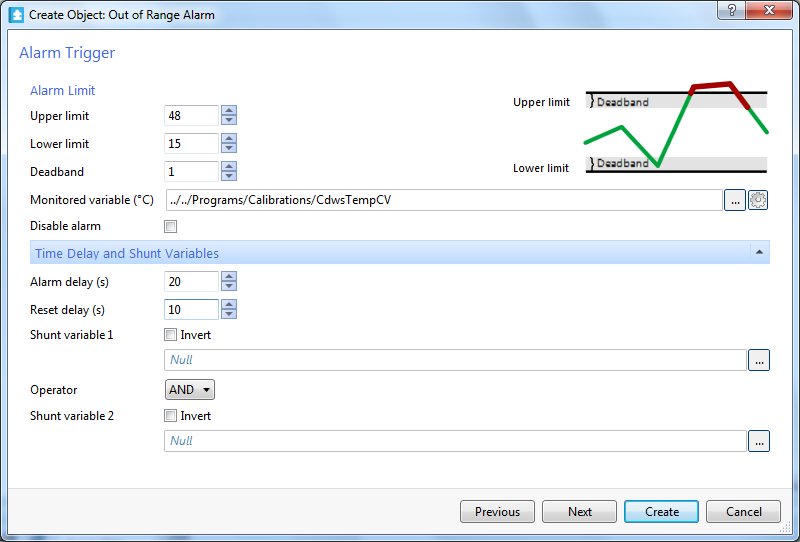
Click Next .
In the Above upper limit message box, type the message to display when the alarm exceeds the upper limit.
action_zoom_plus_stroke 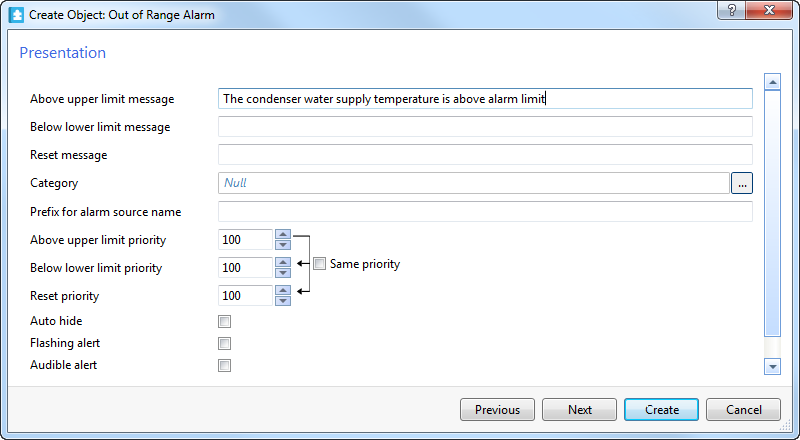
In the Below lower limit message box, type the message to display when the alarm falls below the lower limit.
In the Reset message box, type the message to display when the alarm is reset.
In the Category box, enter a category for the alarm.
In the Prefix for alarm source name box, type a prefix that is added to the beginning of the source name property of an alarm record.
In the Above upper limit priority box, enter the priority for the upper limit of the alarm state.
Select Same priority to let all priorities inherit the value in the Above upper limit priority box.
In the Below lower limit priority box, enter the priority for the lower limit of the alarm state.
In the Reset priority box, enter the priority for the reset state.
Select Auto hide to automatically hide the alarm from the Alarms pane or Alarm View.
Select Flashing alert to make the alarm flash in the Alarms pane and Alarm Views when it is triggered.
Select Audible alert to make the alarm sound when it is triggered.
action_zoom_plus_stroke 
Select Disable state-change logging to prevent an alarm state change from creating an event.
Click Next .
Select the type of acknowledgement to use:
Click No when the alarm does not need to be acknowledged.
Click Single when the alarm needs to be acknowledged in the alarm state.
Click Extended when the alarm needs to be acknowledged in the alarm state and the reset state.
action_zoom_plus_stroke 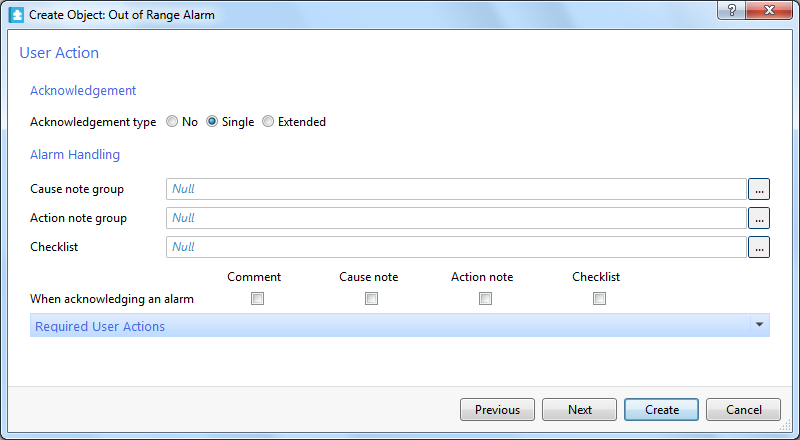
In the Cause note group box, enter the cause note group that you want to connect to the alarm.
In the Action note group box, enter the action note group that you want to connect to the alarm.
In the Checklist box, enter the checklist that you want to connect to the alarm.
Select When acknowledging an alarm: Comment to force the user to add a comment to the alarm before the alarm can be acknowledged.
Select When acknowledging an alarm: Cause note to force the user to edit the connected cause note before the alarm can be acknowledged.
Select When acknowledging an alarm: Action note to force the user to edit the connected action note before the alarm can be acknowledged.
Select When acknowledging an alarm: Checklist to force the user to go through the connected checklist before the alarm can be acknowledged.
Under Required User Actions , select the actions for Comment , Cause note , and Action note to force the user to act on the listed actions.
action_zoom_plus_stroke 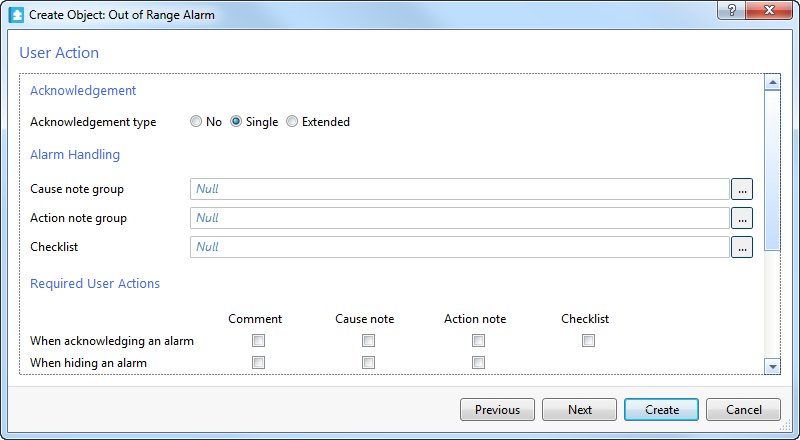
Click Next .
Click the Add attachment button
to add an attachment.action_zoom_plus_stroke 
action_zoom_plus_stroke 
In the Select Object dialog box, select the object you want to attach to the alarm.
Click Select .
In the Display on alarm column, select the check box to automatically open the attachment when the alarm is triggered.
action_zoom_plus_stroke 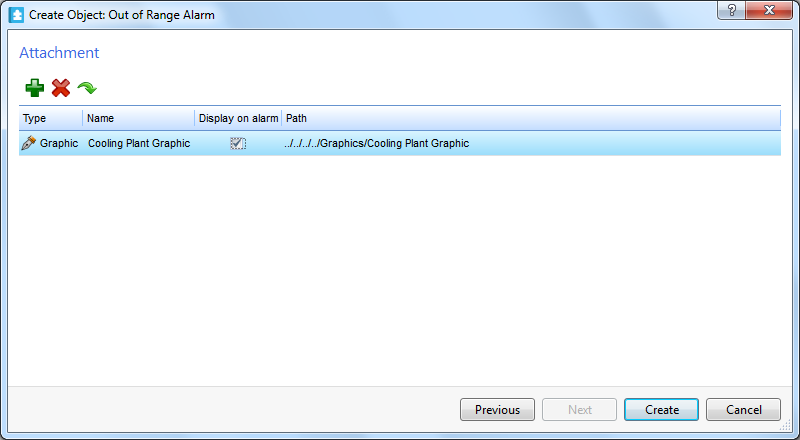
Click Create .
 Out of Range Alarms
Out of Range Alarms
 Create Alarm Wizard – Presentation Page
Create Alarm Wizard – Presentation Page
 Create Alarm Wizard – User Action Page
Create Alarm Wizard – User Action Page
 Create Out of Range Alarm Wizard – Alarm Trigger Page
Create Out of Range Alarm Wizard – Alarm Trigger Page
 Out of Range Alarm Properties – Basic Tab
Out of Range Alarm Properties – Basic Tab
 Create Alarm Wizard – Attachment Page
Create Alarm Wizard – Attachment Page
 Alarm Functions
Alarm Functions
 Alarm States
Alarm States
